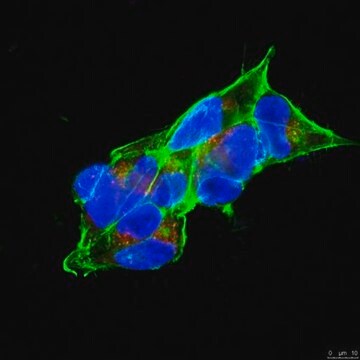MABN852
Anti-APP Antibody, clone 2B3
clone 2B3, from mouse
別名:
Amyloid-beta A4 protein, ABPP, APPI, Alzheimer disease amyloid protein, Amyloid precursor protein, Amyloid-beta precursor protein, Cerebral vascular amyloid peptide, CVAP, PreA4, Protease nexin-II, PN-II
ログイン組織・契約価格を表示する
すべての画像(1)
About This Item
UNSPSCコード:
12352203
eCl@ss:
32160702
NACRES:
NA.43
おすすめの製品
由来生物
mouse
抗体製品の状態
purified immunoglobulin
抗体製品タイプ
primary antibodies
クローン
2B3, monoclonal
化学種の反応性
mouse, human
化学種の反応性(ホモロジーによる予測)
rat (based on 100% sequence homology)
包装
antibody small pack of 25 μg
テクニック
ELISA: suitable
immunocytochemistry: suitable
inhibition assay: suitable
western blot: suitable
アイソタイプ
IgG1κ
NCBIアクセッション番号
UniProtアクセッション番号
ターゲットの翻訳後修飾
unmodified
遺伝子情報
human ... APP(351)
詳細
Amyloid-beta A4 protein (UniProt: P05067; also known as ABPP, APPI, APP, Alzheimer disease amyloid protein, Amyloid precursor protein, Amyloid-beta precursor protein, Cerebral vascular amyloid peptide, CVAP, PreA4, Protease nexin-II, PN-II) is encoded by the APP (also known as A4, AD1) gene (Gene ID: 351) in human. APP undergoes extensive post-translational modification including glycosylation, phosphorylation, and tyrosine sulfation, as well as many types of proteolytic processing to generate peptide fragments. APP is proteolytically processed under normal cellular conditions by alpha-secretase or beta-secretase to generate and release soluble APP peptides, S-APP-alpha and S-APP-beta, and the retention of corresponding membrane-anchored C-terminal fragments, C80, C83 and C99. Subsequent processing of C80 and C83 by gamma-secretase yields P3 peptides. In Alzheimer s disease processing of C99 generates amyloid-beta 40 (Abeta40) and amyloid-beta 42 (Abeta42) that form amyloid plaques. Beta-amyloid peptides are lipophilic metal chelators with metal-reducing activity. They bind transient metals such as copper, zinc and iron. APP can also be cleaved by caspases during neuronal apoptosis. Cleavage at Asp-739 by either caspase-6, -8 or -9 results in the production of the neurotoxic C31 peptide and the increased production of beta-amyloid peptides. In addition to its obvious role in Alzheimer′s disease, the most-substantiated role for APP is in synaptic formation and repair. Its expression is upregulated during neuronal differentiation and after neural injury.
特異性
Clone 2B3 specifically detects Amyloid-beta A4 protein in human and murine neurons. It targets an epitope within 15 amino acids including the beta-secretase cleavage site.
免疫原
A linear peptide corresponding to 15 amino acids from the C-terminal region of human Amyloid-beta A4 protein.
Epitope: extracellular domain
アプリケーション
Research Category
ニューロサイエンス
ニューロサイエンス
Anti-APP, clone 2B3, Cat. No. MABN852, is a highly specific mouse monoclonal antibody that targets Amyloid beta A4 protein and has been tested for use in ELISA, Immunocytochemistry, Inhibiton Assay, and Western Blotting.
ELISA Analysis: A representative lot detected APP in ELISA applications (Thomas, R.S., et. al. (2011). FEBS J. 278(1):167-78; Thomas, R.S., et. al. (2013). Neuroreport. 24(18):1058-61).
Inhibition Analysis: A representative lot inhibited beta amyloid production in MOG-G-UVW culture media (Thomas, R.S., et. al. (2011). FEBS J. 278(1):167-78).
Western Blotting Analysis: A representative lot detected APP in Western Blotting applications (Thomas, R.S., et. al. (2011). FEBS J. 278(1):167-78).
Immunocytochemistry Analysis: A representative lot detected APP in Immunocytochemistry applications (Thomas, R.S., et. al. (2013). Neuroreport. 24(18):1058-61).
Inhibition Analysis: A representative lot inhibited beta amyloid production in MOG-G-UVW culture media (Thomas, R.S., et. al. (2011). FEBS J. 278(1):167-78).
Western Blotting Analysis: A representative lot detected APP in Western Blotting applications (Thomas, R.S., et. al. (2011). FEBS J. 278(1):167-78).
Immunocytochemistry Analysis: A representative lot detected APP in Immunocytochemistry applications (Thomas, R.S., et. al. (2013). Neuroreport. 24(18):1058-61).
品質
Evaluated by Immunocytochemistry in mouse cortical neurons.
Immunocytochemistry Analysis: A 1:100 dilution of this antibody detected APP in mouse cortical neurons.
Immunocytochemistry Analysis: A 1:100 dilution of this antibody detected APP in mouse cortical neurons.
ターゲットの説明
86.94 kDa calculated.
物理的形状
Protein G purified
Format: Purified
Purified mouse monoclonal antibody IgG1 in PBS without preservatives.
保管および安定性
Stable for 1 year at -20°C from date of receipt. Handling Recommendations: Upon receipt and prior to removing the cap, centrifuge the vial and gently mix the solution. Aliquot into microcentrifuge tubes and store at -20°C. Avoid repeated freeze/thaw cycles, which may damage IgG and affect product performance.
その他情報
Concentration: Please refer to lot specific datasheet.
免責事項
Unless otherwise stated in our catalog or other company documentation accompanying the product(s), our products are intended for research use only and are not to be used for any other purpose, which includes but is not limited to, unauthorized commercial uses, in vitro diagnostic uses, ex vivo or in vivo therapeutic uses or any type of consumption or application to humans or animals.
Not finding the right product?
Try our 製品選択ツール.
試験成績書(COA)
製品のロット番号・バッチ番号を入力して、試験成績書(COA) を検索できます。ロット番号・バッチ番号は、製品ラベルに「Lot」または「Batch」に続いて記載されています。
ライフサイエンス、有機合成、材料科学、クロマトグラフィー、分析など、あらゆる分野の研究に経験のあるメンバーがおります。.
製品に関するお問い合わせはこちら(テクニカルサービス)








